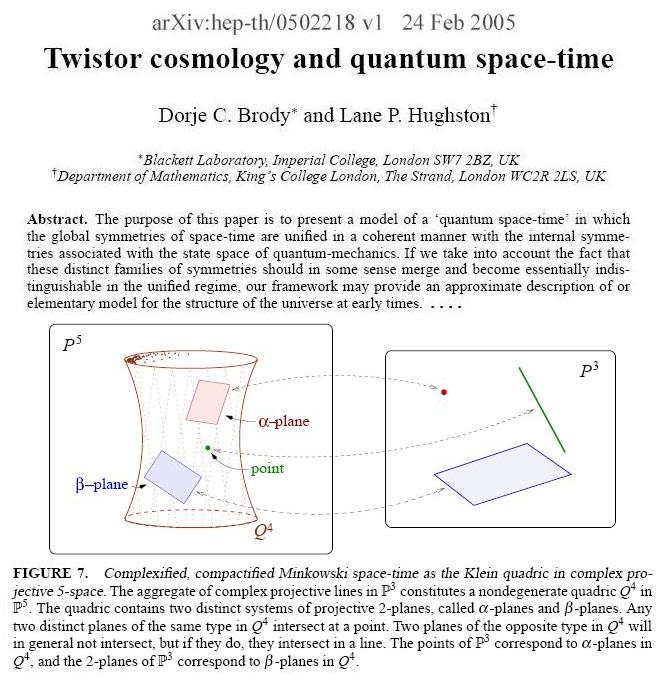Space-Time
and a Finite Model
Notes by Steven H. Cullinane
May 28, 2007
Part I: A Model of Space-Time
The following paper includes a figure illustrating
Penrose's model of "complexified, compactified Minkowski
space-time as the Klein quadric in complex projective 5-space."
For some background on the Klein quadric and space-time, see Roger Penrose, "
On the Origins of Twistor Theory," from
Gravitation and Geometry:
A Volume in Honor of Ivor Robinson, Bibliopolis, 1987.
Part II: A Corresponding Finite Model
The Klein quadric also occurs in a finite model of projective 5-space. See a 1910 paper:
G. M. Conwell, The 3-space PG(3,2) and its group, Ann. of Math. 11, 60-76.
Conwell discusses the quadric, and the related Klein correspondence, in detail. This is noted in a more recent paper by Philippe Cara:
As Cara goes on to explain, the Klein correspondence underlies Conwell's discussion of eight
heptads. These play an important role in another correspondence, illustrated in the
Miracle Octad Generator of R. T. Curtis, that may be used to picture actions of the large Mathieu group M
24.
Related material:
The projective space PG(5,2), home of the Klein quadric in the finite model, may be viewed as the set of 64 points of the affine space AG(6,2), minus the origin.
The 64 points of this affine space may in turn be viewed as the 64 hexagrams of the Classic of Transformation, China's I Ching.
There is a natural correspondence between the 64 hexagrams and the 64 subcubes of a
4x4x4 cube. This correspondence leads to a natural way to generate the affine group AGL(6,2). This may in turn be viewed as a group of over a trillion natural
transformations of the 64 hexagrams.
Geometry of the I Ching.
"Once Knecht confessed to his teacher that he wished to learn enough to be able to incorporate the system of the
I Ching
into the Glass Bead Game. Elder Brother laughed. 'Go ahead
and try,' he exclaimed. 'You'll see how it turns out.
Anyone can create a pretty little bamboo garden in the world. But
I doubt that the gardener would succeed in incorporating the world in
his bamboo grove.'"
Transcript of relevant text for search engines:
Part I--
From "Twistor cosmology and quantum space-time," by Dorje C. Brody
(Imperial College, London) and Lane P. Hughston (King's College
London):
FIGURE 7. Complexified, compactified Minkowski space-time as the Klein quadric in complex projective 5-space. The aggregate of complex projective lines in P3 constitutes a nondegenerate quadric Q4 in P5.
The quadric contains two distinct systems of projective 2-planes,
called alpha-planes and beta-planes. Any two distinct planes of the
same type in Q4 intersect at a point. Two planes of the opposite type in Q4 will in general not intersect, but if they do, they intersect in a line. The points of P3 correspond to alpha-planes in Q4, and the 2-planes of P3 correspond to beta-planes in Q4.
Published in XIX Max Born Symposium, Wroclaw (Poland), 28 September
- 1 October 2004, Springer, 2004, pp. 57-95
Part II--
From "RWPRI Geometries for the alternating group A8," by Philippe Cara, Department of Mathematics,
Vrije Universiteit Brussel
8.2. The Klein quadric
It is well known that the lines of PG(3,2) correspond to the 35 points
of a hyperbolic quadric Q+(5,2) with equation
X0 X1
+ X2 X3
+ X4 X5 = 0
in the five-dimensional projective space PG(5,2). This correspondence is
known as the Klein correspondence and the hyperbolic quadric is then
called the Klein quadric. In what follows, the Klein quadric will be
denoted by Q. On Q there are two families of 15 planes each, which
correspond to the 15 points and the 15 planes of PG(3,2) respectively.
Two different planes of the same family have one point in common and
two planes of different families are either disjoint or share one line. A
{point, plane}-flag p*P of PG(3,2) appears on Q as two planes from
different families which intersect in a line, representing the three lines
in PG(3,2) which are included in P and contain the point p. The Klein
correspondence for PG(3,2) is described in detail in [14].
[14] G. M. Conwell, The 3-space PG(3,2) and its group, Ann. of Math. 11 (1910), pp. 60-76
Published in Finite Geometries: Proceedings of the Fourth Isle of Thorns Conference (July 2000), Springer, 2001, ed. Aart Blokhuis, James W. P. Hirschfeld, Dieter Jungnickel, and Joseph A. Thas, pp. 61-97


